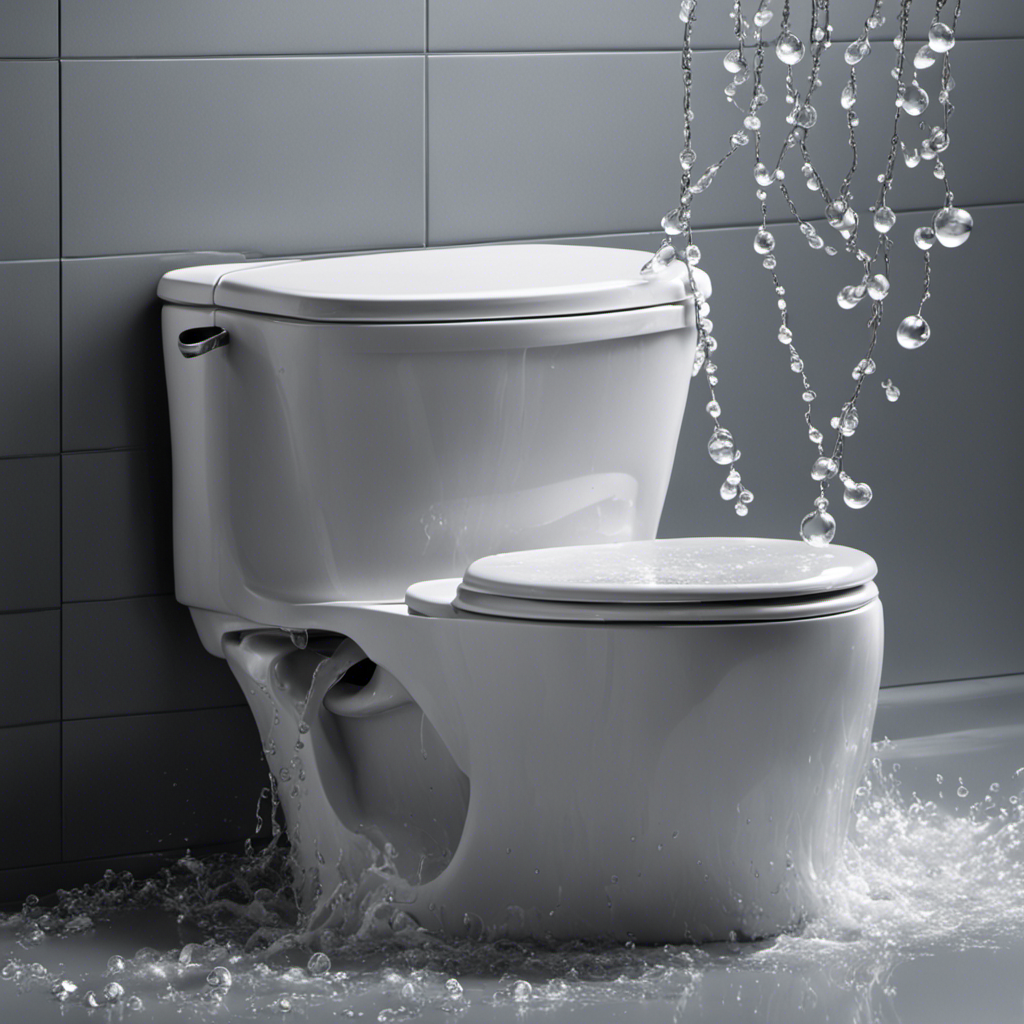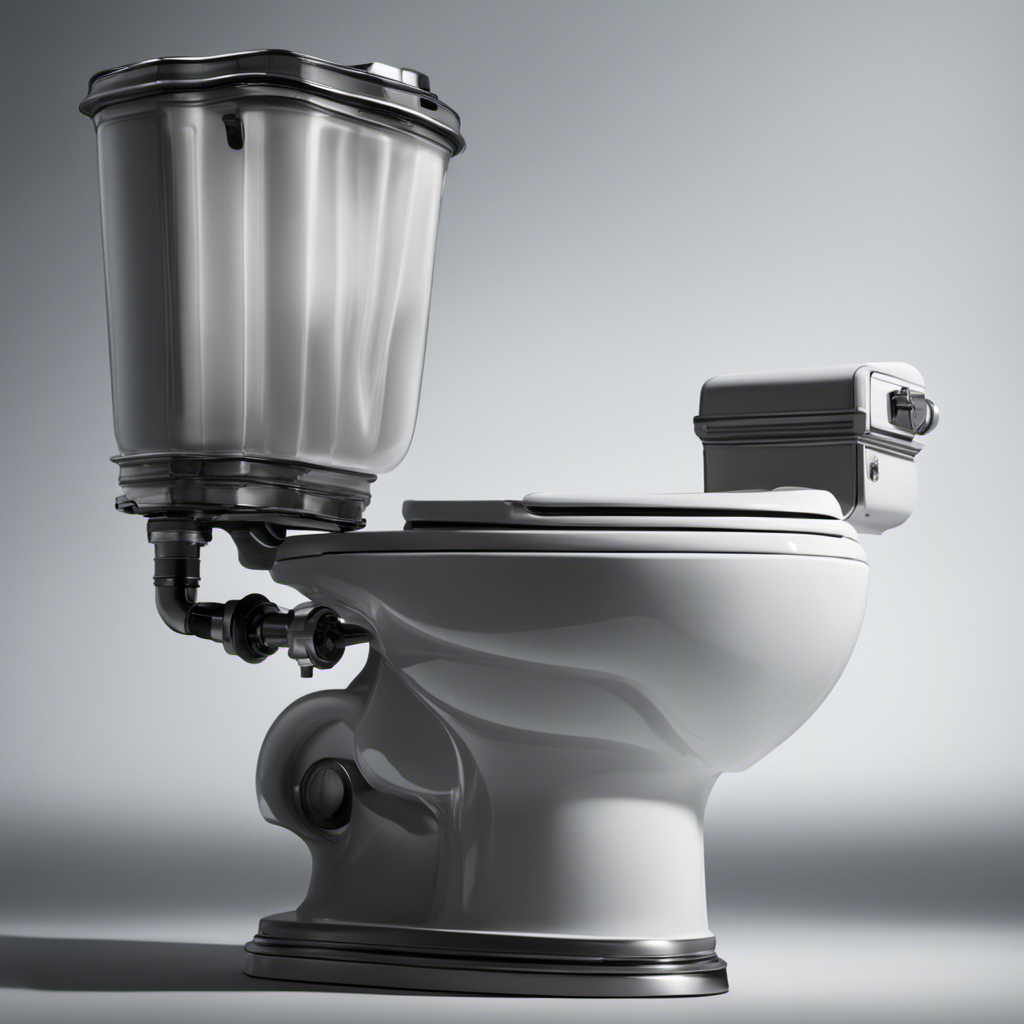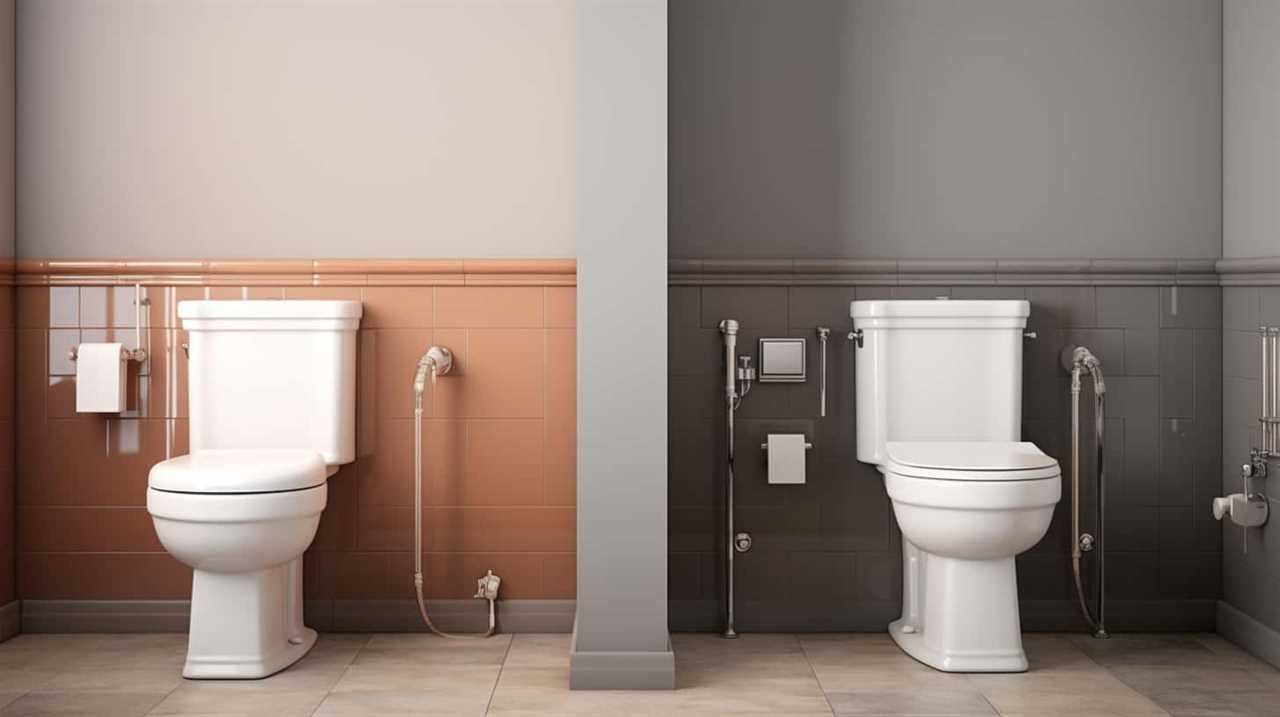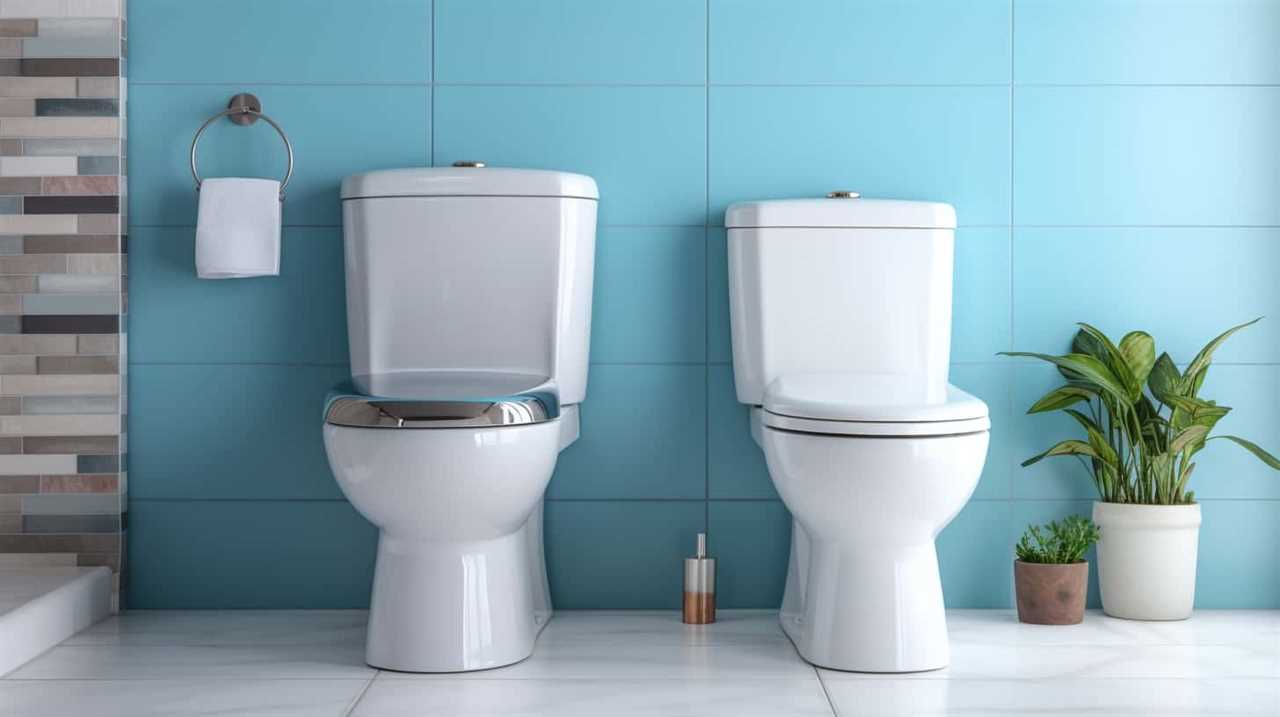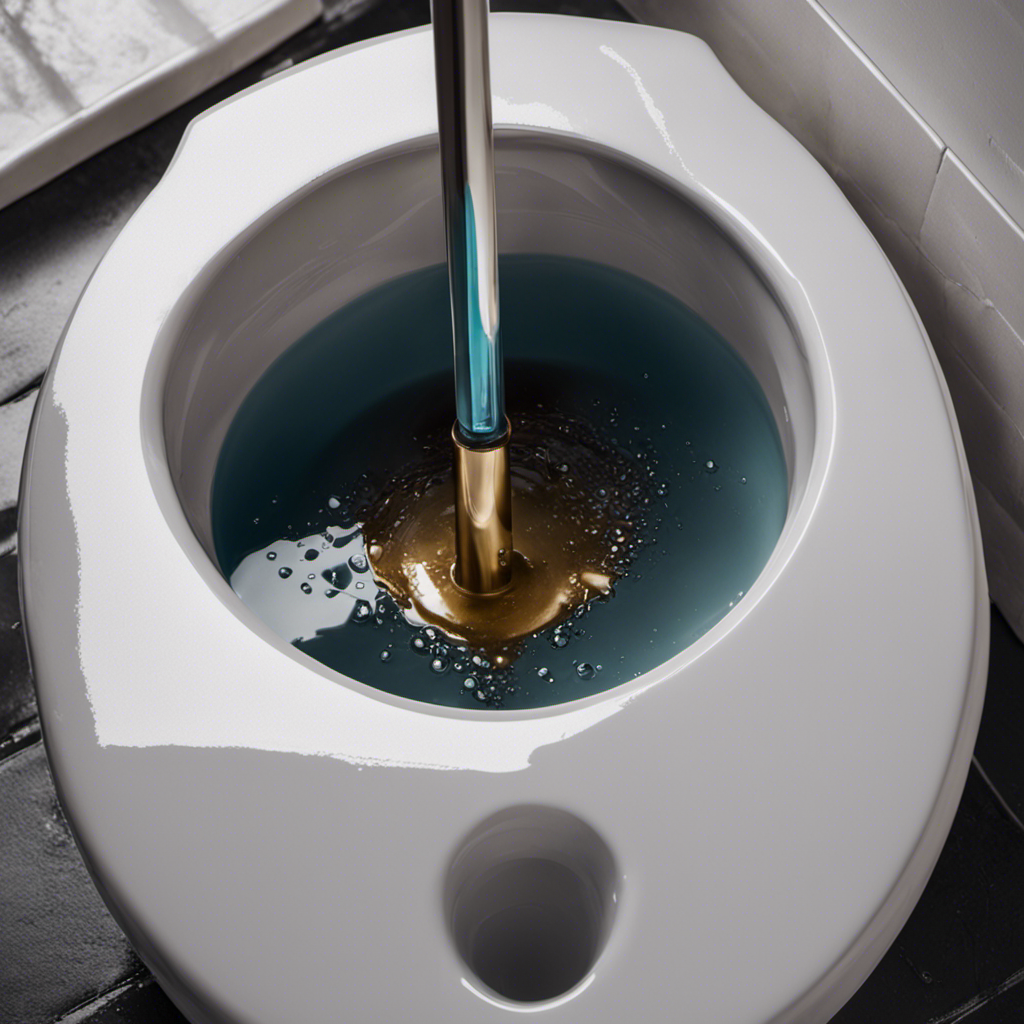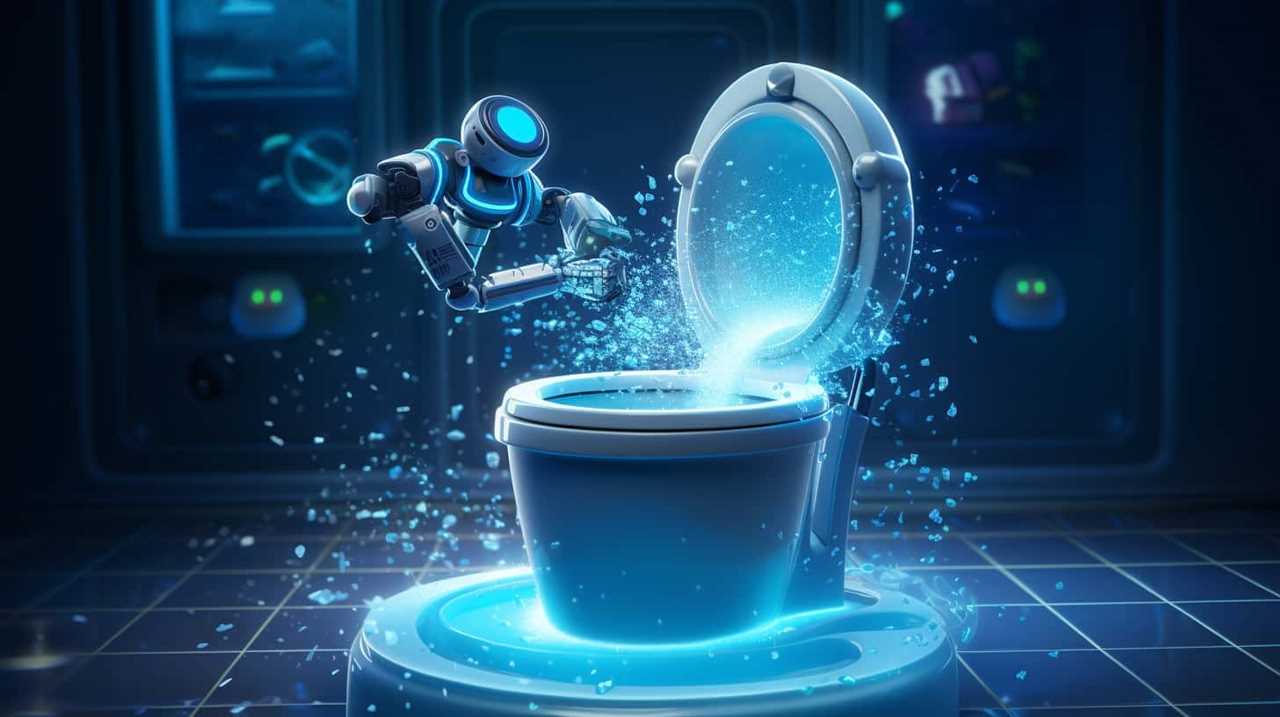Did you know that a running toilet can waste up to 200 gallons of water per day?
As a homeowner, it’s important to address this issue promptly to save water and avoid potential damage.
In this article, I will guide you through the common causes of a running toilet, how to identify the problem, and simple fixes you can try yourself.
We will also discuss when it’s necessary to call a plumber and ways to prevent this issue from occurring in the future.
Additionally, I’ll provide troubleshooting tips to help you tackle this frustrating problem head-on.
Key Takeaways
- A running toilet can be caused by a faulty flapper valve, stuck float mechanism, worn-out fill valve, or broken overflow tube.
- DIY fixes for a running toilet include replacing the faulty flapper valve, adjusting the water level in the tank, inspecting and fixing any leaks, and checking and adjusting the float valve.
- Fixing a faulty flapper valve is necessary to prevent continuous water flow and leakage.
- Adjusting the water level in the tank can prevent continuous running caused by a faulty flapper valve and decrease water pressure, saving water.
Common Causes of a Running Toilet
One common cause of a running toilet is a faulty flapper that needs to be replaced. The flapper is a rubber seal located in the bottom of the toilet tank. It lifts when you flush the toilet, allowing water to flow from the tank into the bowl.
However, if the flapper is worn out or damaged, it may not seal properly, causing water to continuously leak from the tank into the bowl. This constant flow of water can lead to a higher water bill and water wastage.
To fix this issue, simply replace the flapper with a new one, ensuring a proper seal to prevent water from continuously running. Regularly checking and maintaining the flapper can help avoid unnecessary water expenses and conserve water resources.
How to Identify a Running Toilet
Running toilets can be a frustrating issue to deal with, but understanding the common causes can help you troubleshoot and fix the problem.
Some of the most frequent culprits behind a running toilet include a faulty flapper valve, a stuck float mechanism, or a worn-out fill valve.
Luckily, many of these issues can be easily fixed with some basic DIY techniques, saving you time and money on a plumber.
Common Causes of Running Toilets
Why is your toilet constantly running?
There are several common causes for this issue.
One of the main causes is a faulty flapper valve. This valve is responsible for controlling the flow of water from the tank to the bowl. If it is not sealing properly, water can leak into the bowl, causing the toilet to constantly run.
Another possible cause is a damaged fill valve. This valve regulates the water level in the tank, and if it is not working correctly, water may continuously flow into the tank, leading to a running toilet.
Additionally, a broken overflow tube or a worn-out flush valve can also result in a running toilet.
It is important to identify these signs of a running toilet to prevent water wastage and potential damage to your bathroom.
DIY Fixes for Running Toilets
If you’re experiencing a constantly running toilet, there are several DIY fixes you can try.
One common cause of a running toilet is a faulty toilet flapper. The flapper is a rubber valve that controls the flow of water from the tank to the bowl. If it is worn or damaged, it may not seal properly, causing water to continuously leak. To fix this, you can replace the flapper by turning off the water supply, removing the old flapper, and installing a new one.
Another potential issue is a problem with the toilet tank. Check if the water level is too high and adjust the float valve accordingly. Additionally, inspect the fill valve for any leaks or malfunctions.
Simple Fixes for a Running Toilet
When it comes to fixing a running toilet, there are a few key points to consider.
First, a faulty flapper valve is often the culprit behind a running toilet. By checking and replacing the flapper valve if necessary, you can quickly resolve the issue.
Additionally, adjusting the water level in the tank can help prevent the toilet from continuously running.
Finally, it’s important to check for any leaks in the toilet system, as leaks can also contribute to a running toilet.
Faulty Flapper Valve
The toilet’s running because of a faulty flapper valve. This is a common issue that can lead to wasted water and higher water bills if not addressed promptly.
Here are some important points to consider when dealing with a faulty flapper valve:
-
Flapper replacement: To fix the running toilet, the flapper valve should be replaced. This is a relatively simple task that can be done by following a few steps.
-
Water flow: A faulty flapper valve can disrupt the water flow in the toilet tank. This can cause the toilet to continuously run or leak water into the bowl.
-
Checking for damage: Inspect the flapper valve for any signs of damage, such as cracks or wear. If any damage is detected, it is important to replace the flapper valve to ensure proper functioning.
-
DIY or professional help: Flapper replacement can be done as a DIY project with basic tools and some knowledge of plumbing. However, if you are unsure or uncomfortable with the process, it is best to seek professional help to avoid further complications.
Adjusting Water Level
Adjusting the water level in the tank can help prevent a faulty flapper valve from causing the toilet to continuously run. By adjusting the water level, you can ensure that the flapper valve seals properly, preventing any water from continuously flowing into the toilet bowl.
To adjust the water level, locate the water level adjustment screw or float valve on the fill valve. Turn the screw clockwise to lower the water level or adjust the float valve to lower the float. This will decrease the water pressure and help save water.
In addition to adjusting the water level, you can also consider installing water-saving toilet options, such as dual-flush toilets or low-flow toilets, which use less water per flush.
Once you have adjusted the water level, it is important to check for leaks.
Check for Leaks
Check under the toilet for any signs of leaks.
-
Look for water puddles: If you notice any water around the base of your toilet, it could indicate a leak. This could be due to a faulty wax ring or a loose connection between the tank and the bowl.
-
Check the water meter: Turn off all faucets and appliances that use water, then check your water meter. If the meter is still running, it suggests a leak somewhere in your plumbing system, including the toilet.
-
Inspect the toilet tank: Remove the tank lid and check for any visible leaks. Look for cracks, loose fittings, or a constantly running toilet flapper.
-
Perform a dye test: Add a few drops of food coloring into the toilet tank. Wait for about 15 minutes without flushing. If the color appears in the bowl, it means there is a leak.
Regularly checking for leaks is essential for water conservation and toilet maintenance. Identifying and fixing leaks promptly can help save water and prevent costly repairs in the long run.
When to Call a Plumber for a Running Toilet
If you’re experiencing a persistent issue with your running toilet, it might be time to call a plumber. Signs of a malfunctioning toilet include constant water running, a flapper that doesn’t seal properly, or a fill valve that doesn’t shut off completely. These issues can lead to wasted water and increased utility bills.
Additionally, signs of a damaged toilet may include cracks in the tank or bowl, water pooling around the base, or a loose or wobbly toilet. A professional plumber has the expertise to diagnose and repair these issues effectively and efficiently. By addressing the problem promptly, you can prevent further damage and save money in the long run.
Now, let’s explore how to prevent a running toilet in the future.
Preventing a Running Toilet in the Future
One way to avoid future issues with a running toilet is by regularly maintaining the flapper and fill valve. Here are some toilet maintenance tips to prevent water waste:
-
Check the flapper: The flapper is a rubber valve that controls the flow of water from the tank to the bowl. Over time, it can become worn or damaged, causing leaks. Inspect the flapper for any signs of wear and replace it if necessary.
-
Adjust the fill valve: The fill valve is responsible for refilling the tank after each flush. If it is not adjusted properly, it can cause the water level to rise too high, leading to constant running. Adjust the fill valve to ensure the water level is at the recommended mark.
-
Clean the tank: Sediment and mineral deposits can build up in the tank over time, affecting the performance of the flapper and fill valve. Regularly clean the tank to remove any debris and maintain optimal functioning.
-
Conduct regular inspections: Take the time to inspect your toilet for any signs of leaks or running water. Catching and fixing issues early can help prevent water waste and save you from costly repairs down the line.
Troubleshooting Tips for a Running Toilet
Take a moment to inspect the flapper and fill valve to identify any issues with your toilet’s water flow. The toilet flush mechanism is made up of several parts that work together to ensure proper flushing and refilling of the tank. If your toilet is running continuously, it could be due to a malfunctioning flapper or a faulty fill valve. Troubleshooting these components can help you determine the cause of the problem and fix it accordingly. Here are some troubleshooting steps to follow:
| Troubleshooting Steps |
|---|
| Check the flapper for any signs of wear or damage |
| Ensure that the flapper is properly seated and sealing the flush valve |
| Inspect the fill valve for leaks or malfunctioning parts |
Conclusion
In conclusion, a running toilet can be caused by a variety of factors. These include a faulty flapper, an improperly adjusted float, or a worn-out fill valve. By identifying the source of the problem, you can easily fix it with simple adjustments or replacements.
However, if the issue persists or if you’re unsure about making the repairs yourself, it’s best to call a professional plumber.
By taking preventive measures and regularly maintaining your toilet, you can avoid the annoyance and water wastage caused by a running toilet. Remember, a well-functioning toilet is essential for a harmonious and efficient household.
